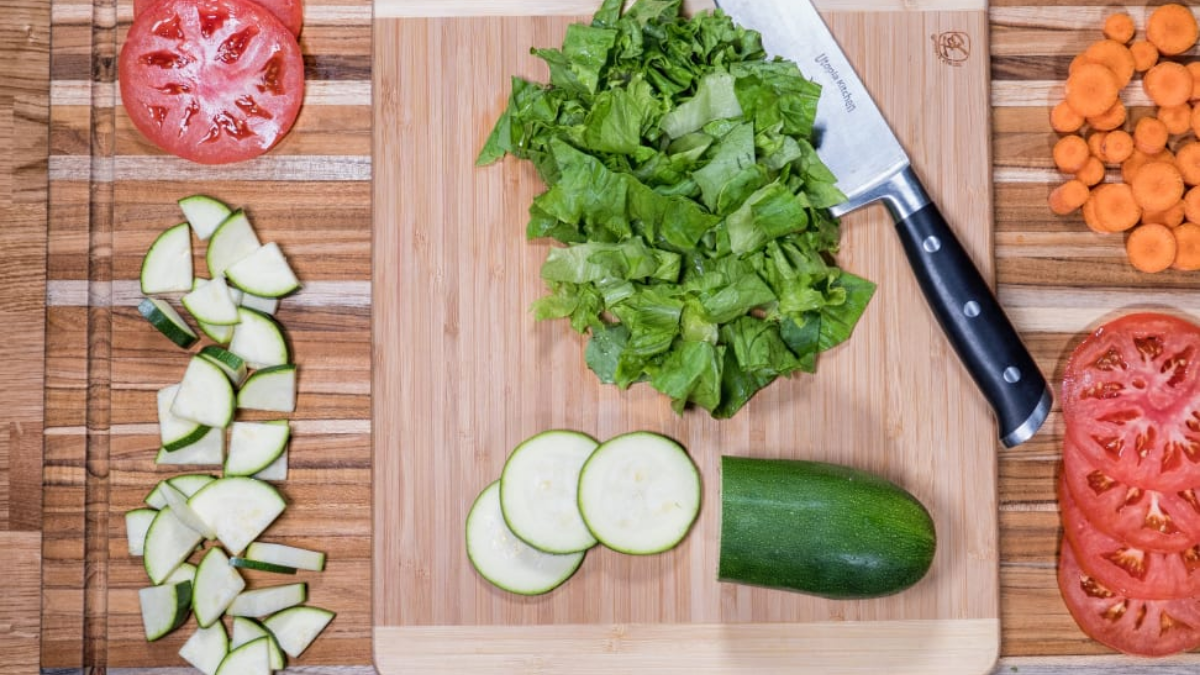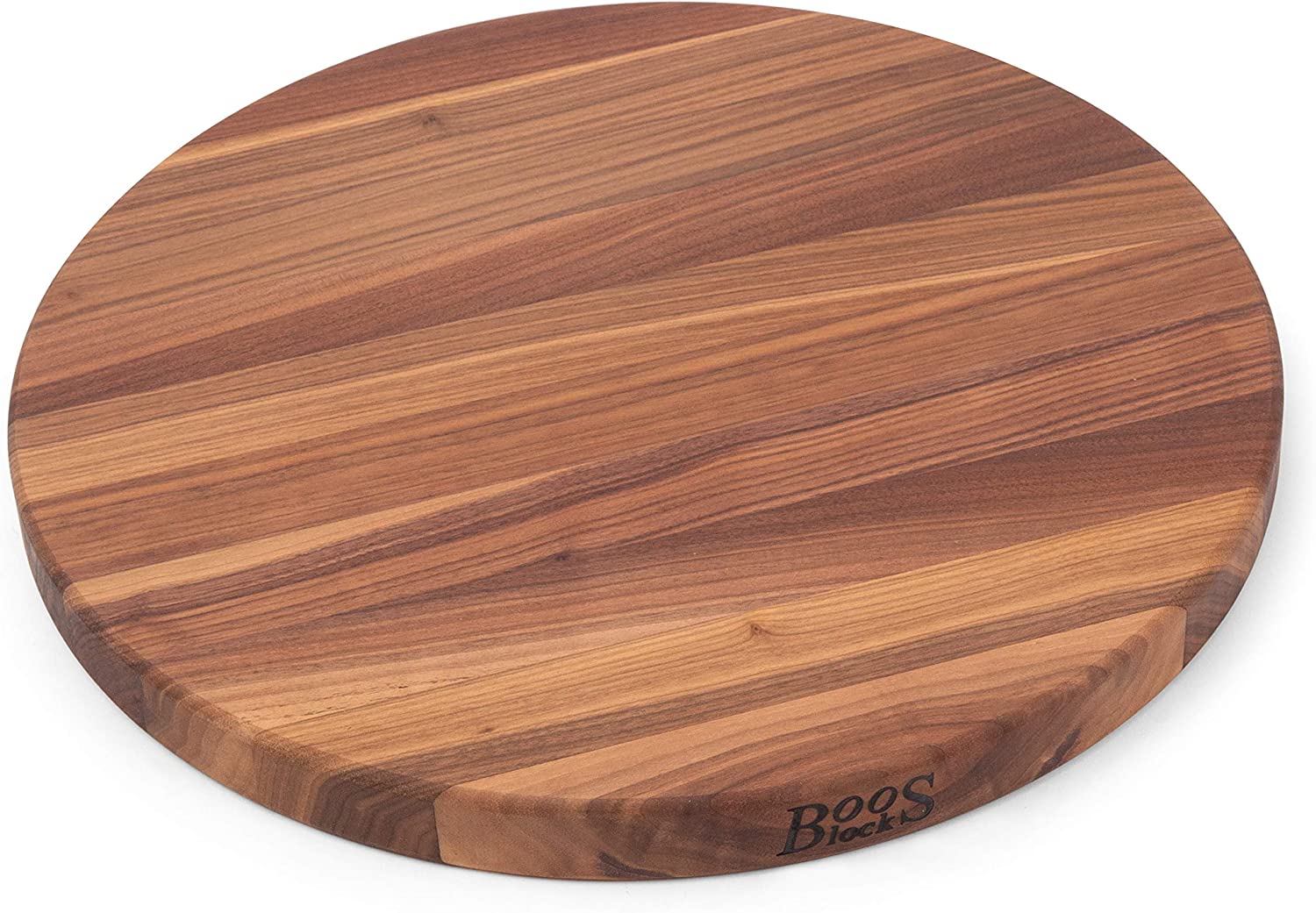A great cutting board can significantly improve your home cooking skills, like an excellent chef’s knife or solid skillet. The best cutting boards offer a sizable work surface and safety for the blades you’re using, whether you’re slicing steak, chopping herbs, or cutting vegetables. But the real issue is: What kind of cutting board should you use? The ideal cutting board for your kitchen will vary depending on the foods you cook and the knives you like, and you might require various cutting boards.
Wood is a wonderful choice for a cutting board in terms of construction. Wooden cutting boards are sturdy, can last a long time, are naturally anti-microbial, and frequently are attractive enough to be used as a serving piece if cared for properly (one drawback of wooden cutting boards is that they are not dishwasher safe and must therefore be hand washed thoroughly to sanitize and regularly treated to prevent warping or cracking).
What is Exactly Cutting Board?
A durable board used for cutting materials is known as a cutting board (or chopping board). For cutting raw materials like leather or plastic, several types of cutting boards are available outside the standard kitchen cutting board. Kitchen cutting boards come in various widths and sizes and are frequently constructed of wood or plastic. Cutting boards made of glass, steel, or marble are also available; while they tend to be harder than hardwood or plastic cutting boards like nylon or Corian, they are easier to clean. A cutting surface is rubbed and damaged more quickly by tools with rough cutting edges, such as serrated knives.
Best Cutting Board for Cooking
Here are some of the best cutting boards:
OXO Good Grips 2-Piece Cutting Board Set
Features:
- One 7.25-in x 10.75-in Prep Board and one 9-in x 12.9-in Everyday Board
- Double-sided, non-porous surfaces resist odors and won’t dull knife blades
- Soft, tapered edges form comfortable handles for carrying
- Integrated drip-catchers and easy-pour corners minimize messes
- Non-slip feet keep boards in place while chopping and slicing
- Durable and dishwasher safe
Texas NSF Polysafe Pastry/Cutting Board with Well
Features:
- Board measures 15 by 20 inches
- Manufactured in compliance with FDA regulations and NSF standards
- The cutting board is non-porous and non-absorbent
- Board is reversible
- Easy to clean: Dishwasher safe
Epicurean Kitchen Series Cutting Board
Features:
- 8-Inch x 6-inch cutting board in natural; made in the USA from Richlite paper composite material; makes the cutting board durable, knife friendly, non-porous
- Designed for everyday use; its thin profile is lightweight and can be used on both sides; a built-in thumb hole allows for easy storing
- Perfect for chopping, slicing, cutting and serving; can be used both in and out of the kitchen
- The cutting board doesn’t require maintenance; it can hold up to the temperature of 350°F so that it can be used as a trivet
John Boos Block WAL-R18 Walnut Wood Edge Grain Reversible Round Cutting Board
Features:
- John Boos Block WAL-R18 round cutting board measures 18 inches across and is 1.5 inches thick
- Made in the USA: Each John Boos Butcher Block and Cutting Board is proudly made in Effingham, Illinois, by skilled craftspeople using time-honored techniques since 1887
- This cutting board is made from sustainably sourced, hand-selected American Black Walnut Wood.
- This board is reversible. Both sides are flat and can be used as cutting surfaces.
- Ideal for cutting and serving pizza
- Care: hand washes and dry. Apply John Boos Mystery Oil regularly (more often in dry climates and when the board is brand new), and use John Boos Board Cream to seal the wood surface after applying Mystery Oil. Oil and cream sold separately on Amazon
- The Professional Choice: Often imitated, Boos Boards and blocks are the preferred cutting surfaces of top chefs and restaurants around the world
- Safe for fine cutlery: Wooden cutting boards are easier on knives than plastic boards (which can dull knives more quickly)
Bamboo 3-Piece Bamboo Cutting Board Set
Features:
- The three boards included in this set cover a variety of food prep, cutting and serving needs; it’s sure to be a valuable addition to any kitchen
- The larger boards are ideal for cutting meats, fruits and vegetables, while the lightweight 8-inch board is perfect for slicing garnishes and serving small appetizer spreads.
- The lightweight medium and large boards feature a handle to hang for storage and easy carrying.
- These boards are crafted from beautiful flat-grain Moso bamboo, making them lightweight and durable yet gentle on knives to preserve their sharpness for continuous use.
- Hand washes or wipes a damp cloth; do not soak in water or wash in the dishwasher.
What to Consider When Buying a Cutting Board?
Which cutting board do you like comes down to a simple question: Which board is ideal for you, your kitchen, and your cooking style? Yes, there are criteria for choosing a good cutting board (all of which we’ve applied to the options here), but for many individuals, the distinction between an excellent cutting board and an OK one may come down to how it feels to use. Here are the four crucial considerations you should make when choosing a cutting board to help you understand:
Material
Cutting boards made of wood are equivalent to cast iron skillets. They are the best, yet they can also be a pain. For instance, hardwood cutting boards are thought to be the greatest choice for protecting knife edges because they cause less harm, but they also need a little more manual labor for cleaning and maintenance. Wooden cutting boards shouldn’t be put in the dishwasher or left dirty or unwashed for extended periods since they can stain and distort. They may also develop scars from repeated use, but you may re-oil them for extended use after you sand them down.
Due to their small weight, plastic cutting boards are frequently simpler to store and much easier to clean, but they are also less solid and durable due to their weight. However, because they are frequently less expensive, changing them after a few years of use may not be as costly as purchasing a hardwood board, which is frequently more than $100.
In addition to being less expensive than wood, teak and bamboo are also said to be gentler on knives than plastic (and glass, which is never recommended for use as a cutting board). Many teak and bamboo boards cost a fraction of what oak cutting boards do yet are just as sturdy.
Due to their frequent use of recycled materials, composite materials are frequently environmentally benign, although they aren’t always suitable for knives.
Size
A big cutting board is comparable to a lovely, sizable painting. You can create more effectively the more room you have. The size you can employ ultimately relies on the amount of storage you have, but if you’re unsure where to begin, a 21-inch width is wonderful; nevertheless, 15 inches is more useful.
Safety
Larger, thicker hardwood boards are more sturdy for cutting and chopping since they are less likely to slide around. For plastic boards to stay on your countertop while you work, they need a non-slip rubber frame or grips. To make boards easier to carry, seek grips on them.
Looks
What are the Food Safety Tips for Cutting Board?
Here are some food safety tips for cutting board:
- Observe proper cutting order: When you prep, cut raw fruit and vegetables first, and then cut raw meat, poultry, and fish second. This helps you avoid cross-contamination. Cutting ready-to-eat foods on a cutting board that recently had raw meat, poultry, or fish can easily spread bacteria that cause food-borne illnesses.
- Clean your board right after cutting any food. It’s a good practice to clean your board after cutting any food thoroughly. It’s safer, makes cleanup easier, and keeps flavors from penetrating the board (giving you the dreaded garlic-infused apple chunks). You can clean any cutting board by washing it with hot, soapy water after each use. Rinse well and air dry, or dry thoroughly with clean towels.
- Sanitize occasionally: To sanitize cutting boards, the USDA recommends a solution of 1 tablespoon of regular-strength liquid chlorine bleach per gallon of water (this solution will be effective for two weeks and no longer). Wipe the cutting board liberally with the solution and allow it to stand for several minutes. Rinse well with water and air, or pat dry with a clean towel.
What Type of Cutting Board is Best?
The ideal cutting board is big, strong, and simple to keep clean when it comes to dicing and chopping in the kitchen. If you can only use one cutting board, pick one made of wood. Cutting boards made of wood are made to withstand even the sharpest blades. Additionally, you won’t need to replace them for several years, making them a worthwhile investment. A plastic cutting board, however, is less expensive and easier to store and clean. The quick answer is the best cutting board truly depends on what you want to get out of it.Plastic and wooden cutting boards are considered hygienic by the FDA as long as they are often cleaned and replaced on schedule. Regarding 21 hygiene, both wood and plastic have their advantages. Wood is naturally anti-microbial, so there may be less chance of missing those nooks and crannies where bacteria may be accumulating than plastic, which can be readily cleaned in the dishwasher.
Conclusion
Every kitchen needs a set of chopping boards, especially if you cut a lot of vegetables for your meals. You can chop on a spotless, slick surface thanks to it. Choose one of these top cutting boards from the internet selection if you don’t want any cuts or knife marks on your kitchen counter.
Cutting boards are frequently disregarded and undervalued, but they are crucial kitchen tools that can save lives and alter the course of a meal. They facilitate quick, precise cutting while upholding cleanliness and order. The cutting boards are available in a variety of sizes, shapes, and materials, including bamboo, plastic, wood, and stainless steel. We adore bamboo and oak chopping boards, but you should check out every board on the list to see which one best meets your needs.







